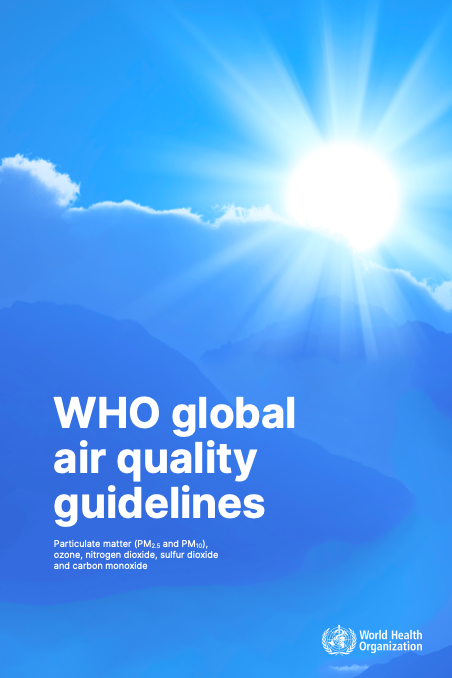Particulates
Description
Including dust; silica; particulate matter 2.5 and 10; diesel particulate matter; smog; microfibres; microplastics; and asbestos.
Share this Subissue on:LinkedIn
Resources
Pollutants in Air and Water: A Getting Started Guide
Pollutants in Air and Water: A Getting Started Guide
Unmanaged and improperly managed pollutants are having a dire impact on human health and are major contributors to the global climate and nature loss crises. Increasing levels of pollution also have significant economic impacts and reduce the productivity, cleanliness, liveability, and overall resilience of communities.
Businesses have a crucial role to play in protecting people and nature. Anchored in research, our Pollutants in Air and Water: A Getting Started Guide aims to support your company as it develops a strategy to eliminate pollutants from its own operations and in its value chain.
Other Resources
WHO Global Air Quality Guidelines
This comprehensive guide was created by the World Health Organisation (WHO) for policy-makers, lawmakers, and technical experts, including industrial stakeholders and environmental impact assessment practitioners. It was created to offer quantitative, health-based recommendations for air quality, with the ultimate goal of providing guidance that can help to reduce the burden of pollutants on health worldwide. It provides specific recommendations on a range of air pollutants, including particulate matter, ozone, nitrogen and sulfur dioxide, carbon monoxide, and more. It also provides recommendations for implementation, monitoring, and evaluation of the guidelines.
Air pollution data portal
The WHO's Air Pollution Data Portal can help you to quickly access data and databases, factsheets, interactive tools, and key publications on ambient and household air pollution.
A Practical Guide For Business: Air Pollutant Emission Assessment
Developed by the Climate and Clean Air Coalition, Stockholm Environment Institute, and IKEA Group, this guide can help you to quantify air pollutant emissions within your value chain. The guide introduces a method for the comprehensive accounting of emissions and provides a six-step approach for developing an air pollutant emission inventory for a broad range of contaminants, including particulate matter (PM2.5, PM10), Sulphur Dioxide (SO2), Nitrogen Oxides (NOx), Ammonia (NH3), and Carbon Monoxide (CO). The guide also introduces approaches to mitigation and implementation, and explains how an emissions inventory can be used for decision-making and strategy.
Getting to the Heart of the (Particulate) Matter
The World Health Organisation estimates that more than 99% of the world’s population breathes air that exceeds its health-based air quality guideline limits, and that millions of premature deaths can be attributed annually to breathing in air pollution. This explainer from NASA can help you to understand the scale and scope of the air pollution crisis, and especially of the dangers of particulate matter. It explains the nature and sources of particulate matter pollution; outlines the implications for human health; and highlights the efforts that are underway to determine the types and sources of particulate matter most harmful to humans.
Microplastics are raining down from the sky
This explainer from National Geographic can help you to understand the extent of airborne microplastic and nanoplastic particulate pollution, and the implications they may have on human health and the environment.
Microplastics are in the air we breathe and in Earth’s atmosphere, and they affect the climate
Microplastics can be found in every environmental system on the planet, and are making their way into the food we eat, the water we drink, and - increasingly - the air we breathe. Looking beyond the immediate health consequences, this article (and accompanying report) can help you to understand how airborne microplastics behave in the atmosphere and how they contribute to climate change.
The Plastic Leak Project Guidelines
This comprehensive publication provides the first science-based methodology to map and measure plastic leakage across corporate value chains. Part of the Plastic Leak Project, this document will provide sustainability managers and corporate decision-makers with a framework for understanding where (and how much) leakage is occurring, and can help you to create impactful strategies and actions that effectively address plastic pollution and mitigate key business risks. Also available is a Plastic Leak Project Brief, which provides decision-makers with an overview of the guidelines, a summary of the challenges they help address, the business value of this metrics-based approach to building a plastics strategy, and more.
Asbestos Information
This is a good source of information on the basics of asbestos. It explains what asbestos is, how it's used, and the effects it can have on human health.
Air Quality Stripes
This resource can help you to better visualise and explain key trends in particulate pollution. Inspired by the Climate Stripes, these air quality stripe images show the change in particulate matter (PM2.5) air pollution from 1850 to 2021 in cities around the globe.








